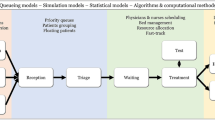Abstract
Cities with under 100,000 in population expend a significant portion of their budgets on emergency services. One option that a number of these cities have considered for improving service and cutting costs is training personnel to handle both police and fire roles. In this paper we describe a hierarchy of models that we have used to assess the performance viability of a merger as well as to design specific deployment plans. The modeling environment is more complex than a traditional police or fire system. We need to model the response pattern of four or more patrol units along with the simultaneous dispatch of fire equipment from one or more fire stations. The major contribution of the paper is the manner in which a series of models is linked together to forecast a wide range of performance measures under differing dispatch assumptions. We use a queueing model of police patrol to calculate steady state probabilities and expected delays without preemption. We then model two types of preemptive dispatch strategies utilized in responding initially to a major fire by superimposing a binomial distribution on the basic queueing model. There is also a travel time simulation model to calculate conditional expected response time statistics. The queueing models and the travel time simulation are then combined to estimate unconditional expected values. Lastly, we describe a simulation model used to address transient performance issues that are of concern during a major fire.
Similar content being viewed by others
References
US Department of Commerce,City government finances, 1982–1983, GF83 # 4 (1984).
K.R. Chelst, Police-fire merger: a preimplementation analysis of performance and cost, J. Urban Affairs 9, no. 2 (1987).
K.R. Chelst, A public safety merger in Grosse Pointe Park, Michigan — a short and sweet study, Interfaces 18, no. 4 (1988).
K.R. Chelst and L. Matarese, A study of police/fire/EMS alternatives in Kentwood, MI, Report to the City Council of Kentwood, MI (1988).
L.S. Frankel, Police/fire consolidation in municipalities, 10,000 and over, Urban Data Service 9, no. 9 (1977).
L.S. Frankel, Police/fire consolidation in municipalities, 10,000 and under, Urban Data Service 10, no. 10 (1978).
L. Green, Multiple dispatch queueing model of police patrol operations, Management Sci. 30, no. 6 (1984).
L. Green and P. Kolesar, Testing the validity of a queueing model of police patrol, Management Sci. 35, no. 2 (1989).
J. Halpern, Fire loss reduction: fire detectors vs. fire stations, Management Sci. 25, no. 11 (1979).
M. Hayman, Public safety departments: combining the police and fire functions, Management Information Service Report 8, no. 7 (1976).
R.L. Keeney, A utility function for the response time of engines and ladders to fires, Urban Anal. 1 (1973).
P. Kolesar and E. H. Blum, Square root laws for fire engine response distances, Management Sci. 19, (1975).
J.D. Mayer, Emergency medical service: delays, response time and survival, Med. Care no. 8 (1979).
I. Schoenfeld, Update: public safety departments — combining police and fire functions, Management Information Service Report 14, no. 11 (1982).
W. Spelman and D. K. Brown,Calling the police: citizen reporting of serious crime, Police Executive Research Forum, Washington, DC, (1981).
W. E. Walker, J. M. Chaiken and E. J. Ignall,Fire Department Deployment Analysis (North-Holland, 1979).
Author information
Authors and Affiliations
Rights and permissions
About this article
Cite this article
Chelst, K. Queueing models for police-fire merger analysis. Queueing Syst 7, 101–124 (1990). https://doi.org/10.1007/BF01158787
Received:
Revised:
Issue Date:
DOI: https://doi.org/10.1007/BF01158787




